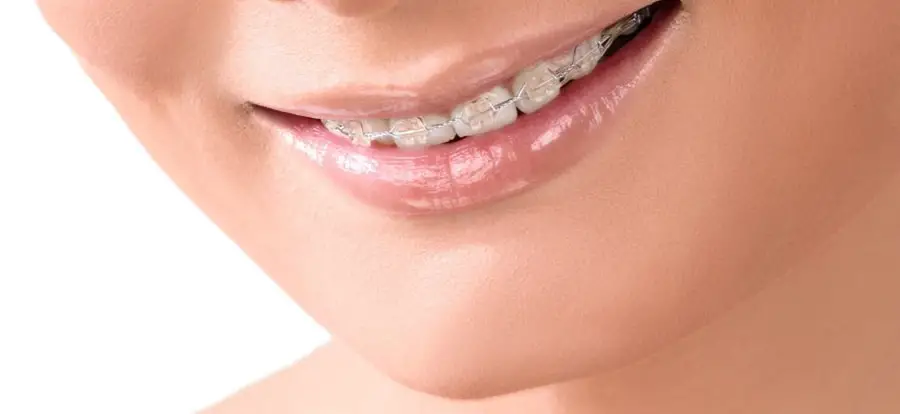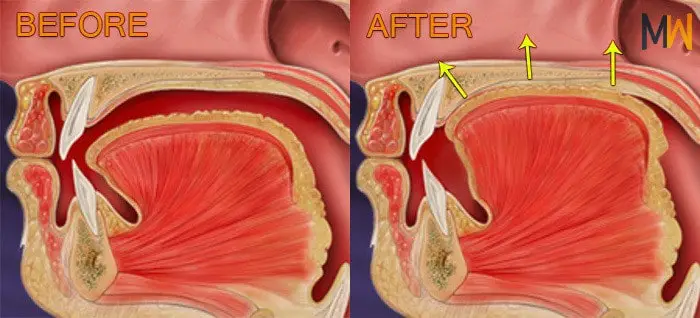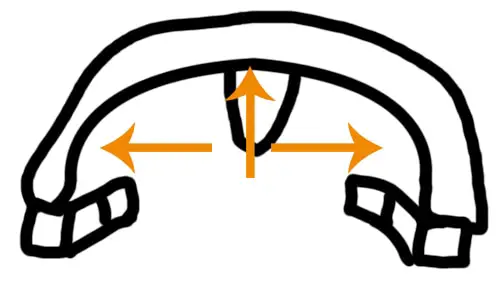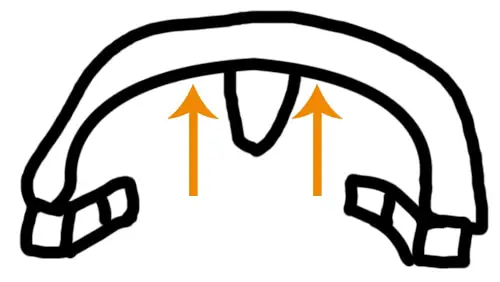
Mewing is growing in popularity because it can help improve your bone structure to give you a model-like appearance. Dr. Mew has also stated that the tongue is the best palate expander. So how does mewing compare to traditional braces? Are the two interchangeable?
If your teeth are very crooked, crowded, etc., mewing will not fix your teeth, even as a kid. Mewing can help you realign your teeth and jaw, but it will not straighten your teeth. However, if you are still young, it’s a great preventative tool to prevent you from needing braces in the future.
What Is Mewing?
Mewing is a normal tongue posture. The idea is that mewing will help you reshape or mold your facial bone structure because you have to hold the proper posture 24/7. Mewing can help you get higher cheekbones, a chiseled jawline, cheek hollows, etc. However, mewing has other benefits other than just aesthetic ones.

For instance, a study showed that a sleeping tongue posture (with the tongue on the bottom of the mouth) increases the likelihood of snoring (Tingey et al., 2011). Mewing encourages nasal breathing, which can help reduce snoring and help people who have sleep apnea.
To see more scientific studies that relate to mewing, click here.
Can Mewing Replace Braces?
Despite all of the benefits that you can get, mewing cannot replace braces. With proper mewing technique, you are not actually touching your teeth with your tongue. If you have any issues with your teeth, adjusting your tongue and mouth posture cannot replace braces. If your teeth are crowded and crooked, mewing cannot shift them to make them straighter.
However, mewing could be helpful if you are still developing. For instance, mouth breathing, lack of hard foods, and improper tongue posture can cause malocclusions, or misaligned teeth (Grippaudo et al., 2016).
You can prevent malocclusions by mewing because it corrects the factors that cause it. However, it is not a guarantee that your teeth will be perfectly straight. But it could help decrease your chances of developing an overbite, crowded teeth, etc.
How Do I Mew?
- Straighten your neck and back.
- Make a mouth seal by closing your lips. It will help encourage nasal breathing.
- Use your lower jaw to support your upper jaw. Your teeth should touch, but they should not be clenching.
- Flatten your tongue on the roof of your mouth.
- Contract the chin muscles to help you force your tongue onto your palate.
- Breathe through your nose while your mouth is closed.
- Try to hold this position as long as you can. Do it throughout the day, and eventually, it will become a habit.
Flatten your whole tongue and not only the tip. You want your entire tongue to rest on the palate of your mouth. You cannot completely flatten your tongue since the palate is naturally curved. So try to contour your tongue until you can cover as much surface area as you can.
The goal is to try covering as much of the palate as you can. Try to apply pressure evenly and gently. You must focus on applying gentle pressure to your palate. Using more force for shorter amounts of time will not speed up the results.
You can see the changes in your bone structure if you exert a gentle pressure over a long period. You will not get results if you focus on merely using more pressure for a shorter period. So gently applying pressure for 20 minutes several times a day will be more effective than pushing extremely hard on your palate for 5-15 minutes. But your goal is to be able to have your tongue on the roof of your mouth 24/7.
How Can I Mew With Braces?
Mewing cannot replace braces. But if you plan on getting braces, can you still mew to reap the other benefits? Yes! You only need to tweak the steps slightly, depending on what kind of braces you have.
First and foremost, you should ask your doctor if your braces are pulling your upper teeth forward or backward. If your upper teeth are being pulled backward, mewing will be counterproductive, and you might want to get a second opinion. You would be reducing your oral space, which is bad for oral function and aesthetics in the long term.
Otherwise, if your teeth are being pulled forward or just straightened and you have Invisalign or metal braces, you should not have that much trouble adjusting your tongue posture. As long as you can flatten your tongue on your palate without getting in the way of your braces, you should be fine.
However, it may be harder for you if you have lingual braces. The brackets are on the back of your teeth, so you may find it challenging to flatten your tongue without touching the brackets.
Remember to not push on your teeth. Pushing on your braces and teeth will be counterproductive. You may end up having to wear them longer to fix your teeth.
You should also avoid pushing on the sides of the dental arch as you do with normal mewing:

Instead, just push directly upwards:

When you mew without braces, the goal is to expand your palate. Since braces lock our teeth in place, you need to focus on forward growth and facial upswing. You need to create an upward force with your tongue. Be sure the tongue is only touching the palate. That way, your braces will be able to straighten your teeth while your tongue posture enhances your appearance.
Does Mewing With Braces Work?

As mentioned earlier, you cannot expand your palate quickly with braces. That is because braces prevent palate widening or expansion. However, that does not mean practicing proper tongue posture is a bad idea.
Proper tongue posture can still help you breathe properly, prevent snoring, relieve sleep apnea, etc. Plus, it could help you enhance your facial features, too!
Ideally, you should speak to your dentist first to determine if it would be okay for you to mew while you have braces. If your braces are pushing your teeth outward, you should be able to mew without interfering with your progress.
Some braces retract the teeth to your airway, so mewing might counteract your progress. That is because mewing encourages your palate to expand, so your dentist might advise you to avoid mewing until you take off your braces and retainer.
Should I Start Mewing After I Get My Braces Removed?
You can start mewing after you remove your braces and finish wearing your retainer. However, you should be careful about mewing with a retainer, because switching between mewing during the day and wearing the retainer at night will rock your teeth back and forth, causing them to become loose.
While mewing has better results, the younger you start, that does not mean mewing will not work when you are older.
Mewing has worked spectacularly for 18-21-year-olds, who are technically fully developed at that point. So by that logic, anyone older than that should still be able to see results. However, it may take longer to see changes.
To see people’s progress with mewing, click here.

If you are unsure about mewing after you remove your braces, you can speak to your orthodontist or dentist about your tongue posture and if your palate is too small. They can help you find ways to expand your palate and how to correct your tongue posture if you are still finding it hard to mew after removing your braces.
You should still be able to see results once you remove your braces. Most people have to wear retainers after they get their braces removed. You can mew with retainers as long as you learn how to do it with retainers properly.
To learn how to mew with retainers, click here.
Conclusion
While there are cases of people fixing their teeth with mewing out there, don’t pin your hopes on it. Mewing cannot serve as a replacement for braces, especially if your teeth are rather messed up. It could help prevent malocclusions like misaligned teeth, especially when you are young. However, it will not be able to fix crowded or crooked teeth.
Luckily, you can still mew with braces as long as you are not interfering with your braces. That way, you can still try to enhance your facial bone structure and fix your teeth with braces at the same time.

